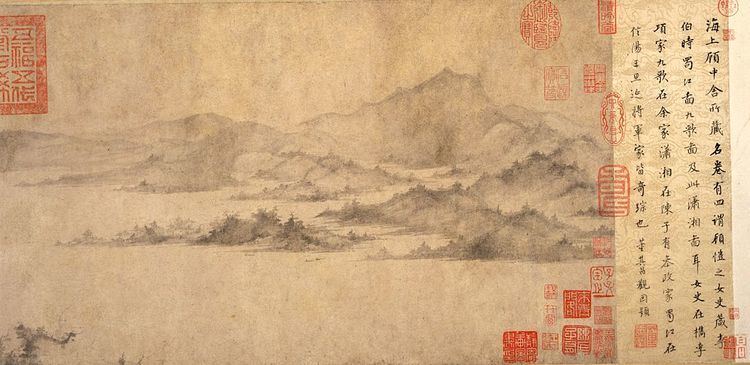 | ||
The Eight Views of Xiaoxiang (Chinese: 潇湘八景; pinyin: Xiāoxiāng Bājǐng) are beautiful scenes of the Xiaoxiang region, in what is now modern Hunan Province, China, as having been written in the poems, depicted in the pictures and known among the people, from the time of the Song Dynasty. The Eight Views of Xiaoxiang can refer either to various sets of paintings which have been done on this theme, the various verse series on the same theme, or to combinations of both. The Xiaoxiang theme should be viewed as part of a long poetic and artistic legacy.
Contents
Among the earliest extant artistic depiction of the Xiaoxiang region can be found in the renowned painter Dong Yuan's masterpiece Xiao and Xiang Rivers. The original set of eight painting titles were done by painter, poet, and government official Song Di (ca. 1067 – ca. 1080), during the reign of Shenzong, in the Song dynasty. A complete version of Song Di's Eight Views of Xiaoxiang has not survived.
The eight scenes
Symbolism
The Eight Views of Xiaoxiang is thematically part of a greater tradition. Generally, it is a theme that as artistically rendered in painting and poetry tends towards the expression of an underlying deep symbolism, such as exile and enlightenment. Furthermore, each scene generally expresses certain, sometimes subtle references. For instance Level Sand: Wild Geese Descend may refer to the historical exile of Qu Yuan in this region and to the poetry which he wrote about it. "Level Sand" may be seen as a reference to Qu Yuan because the Chinese character for level, Píng, was his given name (Yuan was a courtesy name). Furthermore, due to his having drown himself in one of the often sandy rivers of this region to protest his unjust exile, Qu Yuan was often referred to in poetry as "Embracing Sand", for instance by Li Bo. The wild goose is one of the hallmark symbols of Classical Chinese poetry, with various connotations: the descent of the goose or geese, combined with the descent to the level sand, signifies that the geese are flying south, the season is Autumn, and the forces of Yin are on the rise (thus adding to the involved symbolism).
Influence
The Eight Views of Xiaoxiang inspired the people of Far East to create other Eight Views in China, Japan and Korea, as well as series of other numbers of scenes.
In China various versions of The Eight Views of Xiaoxiang have been inspired by the original series, as well as inspiring other series of eight scenes. The Eight Views of Xiaoxiang became a favorite theme of Buddhist monks.
Works covering the Eight Views include a set of paintings by Wang Hong (in the Princeton University Art Museum), now thought to be the earliest surviving depiction of the Eight Views, a set of paintings attributed to Mu Qi (parts in the Kyoto National Museum), and others.
